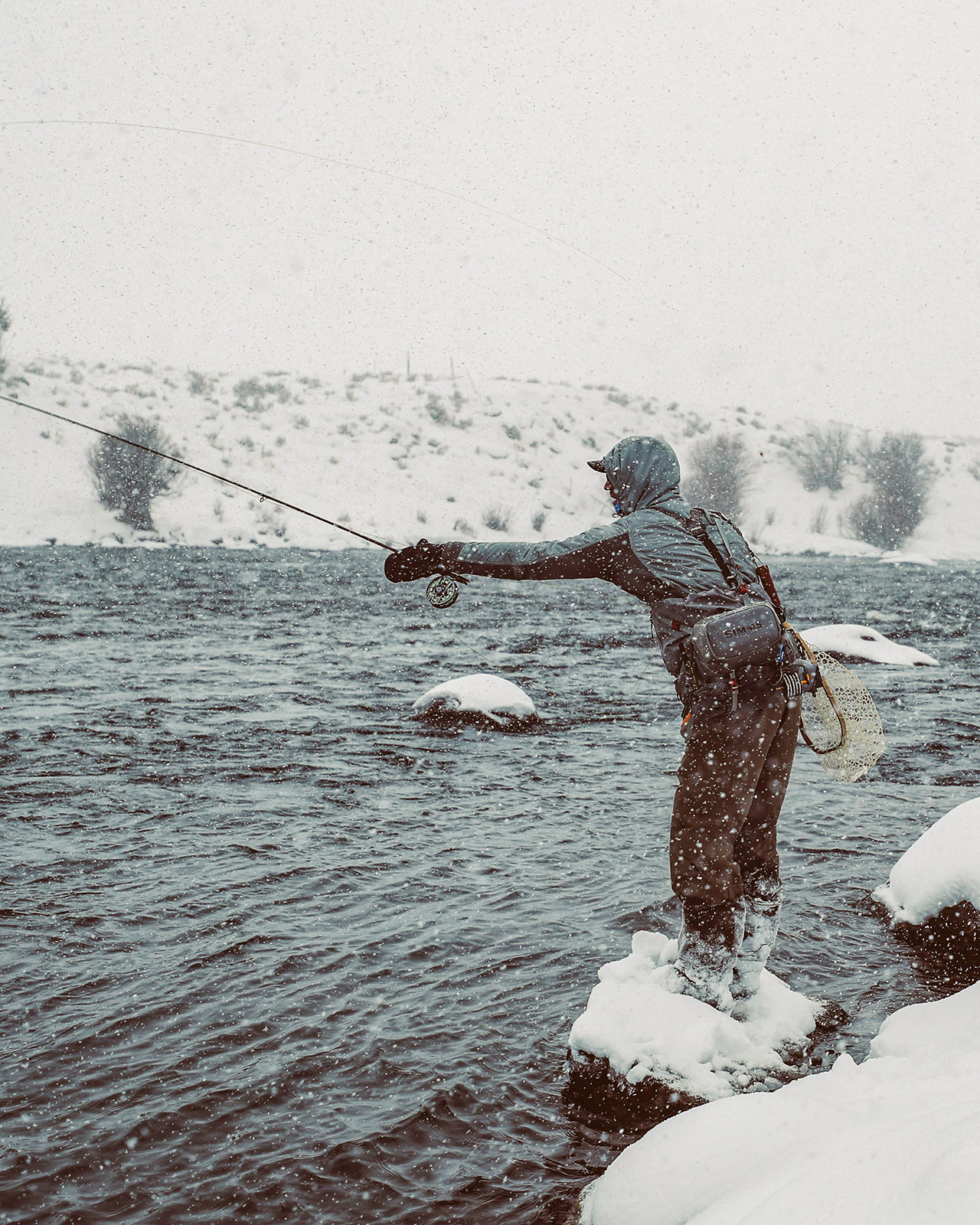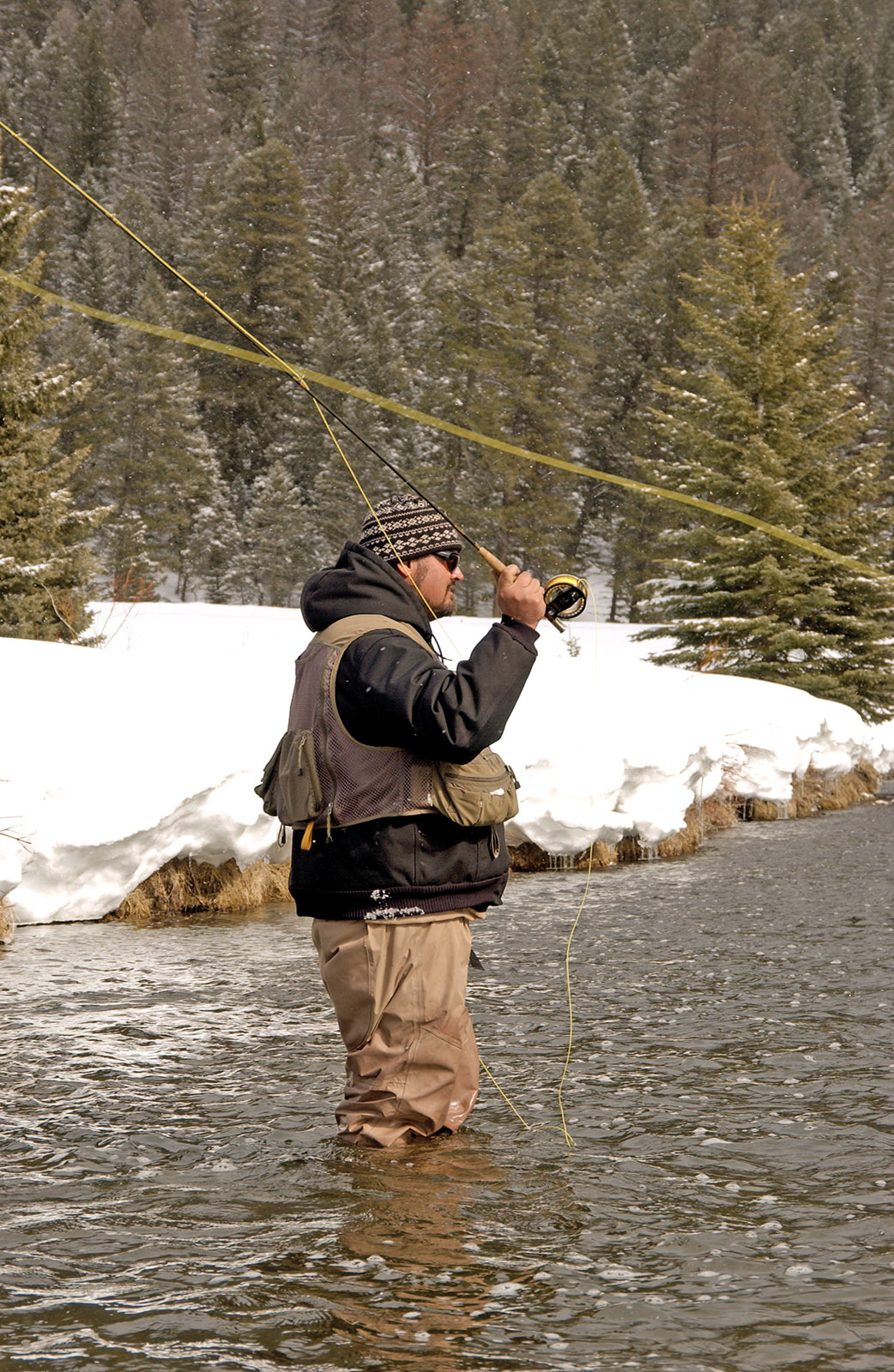Home Alone

by Sean Jansen
The benefits of winter fly fishing.
Shoveling snow out of the driveway and scraping ice from the windshield as it defrosts with the heater on full blast isn’t the way most fly-fishing trips start. But that’s the beauty of it. A fresh layer of snow means the rivers are devoid of people, though the mountains from which the rivers drain are a different story.
Coffee warms the hands whilst the steam fogs up your vision. The temperature in the car is the same as that outside. The road is layered in white, and the highway lines reveal themselves when they can. Slowly, the defroster is turned down, and the coffee begins to awaken and warm your soul. The canyon is in sight, and the story has only just begun.
But that’s the beauty of it. A fresh layer of snow means the rivers are devoid of people, though the mountains from which the rivers drain are a different story.
The road winds its icy way, and the drive is longer for it, though there is hardly any need to rush. Winter is the older, meaner brother to its counterpart summer. The days of early-morning bliss and afternoon dry-fly hatches exist now only in memory. The rising temperatures are no longer your worst nightmare but have instead become your best friend. The trees and riverbanks are blanketed with snow, and there is not a single footprint from past anglers. You’re the angler of present.

Now, the angler of present is there for a single reason: solitude. The droves of humans that littered the banks are nowhere to be seen. The pullouts adjacent to the river are empty lots of asphalt and dirt, sans the treads of tires and footprints from felt and sandal soles. Boots finish the multi-layered insulation system of your choosing. The daytime high is near freezing, and the water temperature hovers only slightly above that. Steam rises from the river—rather than from your now-cold coffee—and the trout sit and wait in the deep slow pools, waiting to nibble on whatever happens to appear directly before them.
Like the angler’s own sluggishness in the river, the trout have little to no desire to move. They conserve energy by swimming around only during the heat of the day, so don’t expect a giant brown to crush a mouse pattern on the top of the water. Instead, cover every inch of water and gaze at the indicator, watching intently for whatever flicker it shows. The take will be subtle.
Anglers who consistently fish in winter will say, “It isn’t about numbers; it’s simply about getting out there.” This quiet, unhurried attitude mirrors that of the trout. The only thing you’re likely to hear is the rush of water around your legs as you wade into the comfort zone. The line slips through your guides as the water collects and turns to ice, slowing the release of your cast. Snowflakes fall on your hood and shoulders, collecting into chilling piles. Other species that frolic the river practice their daily routines, adapting to the changing of the seasons. Looking both up- and down-river, you notice one consistent thing: solitude.
Like the angler’s own sluggishness in the river, the trout have little to no desire to move. They conserve energy by swimming around only during the heat of the day, so don’t expect a giant brown to crush a mouse pattern on the top of the water.
Now the rod’s guides are frozen solid, inhibiting your ability to cast, but the chapstick in your pocket has now become the lube for your trout desires. Chapstick, Vaseline, Gink, and funny enough, Vagasil, all work as lubrication, allowing your line to flow freely through the guides even on the coldest days. And as line flies from the reel and out your rod, mending beautifully into that deep pool, the indicator dances like the latest twerk from a pop-music video.

The set of the hook coincides with the flow of the river; a gentle lift in the rod is all it takes to connect with the trout slurping that deeply dredged fly. The resistance resembles that of late summer: a quick fight rather than a marathon dragging you into your backing. The quality of the fish, however, is unhindered by the strength it possesses in its fight.
The complexion of the fish is dulled, like the palette of the surrounding environment, masking the explosion of colors they will achieve in the months to come. The chrome feel of the trout mimes that of Atlantic salmon or steelhead, and is equally as pretty and satisfactory when at hand. The release is gentle and quick as the fish darts back to that deep hole to wait out winter, or until another appetizer drifts or swings directly in front of it.
